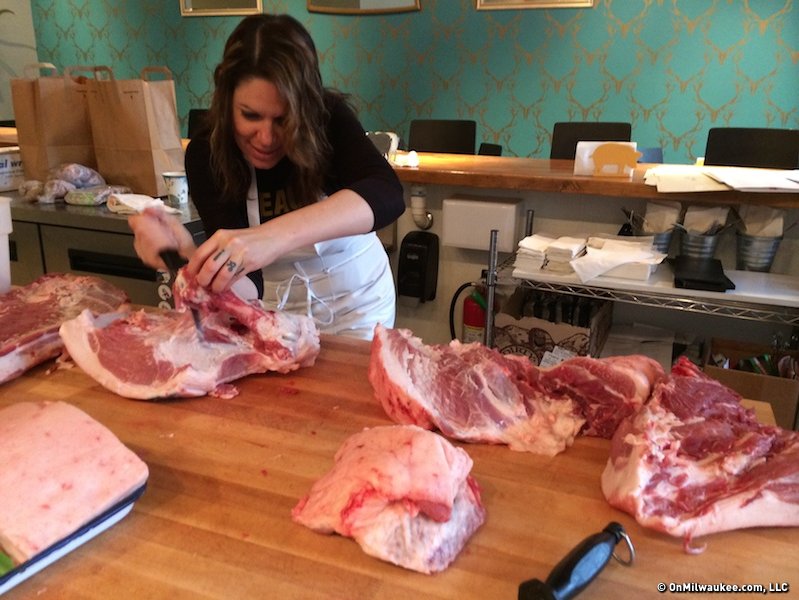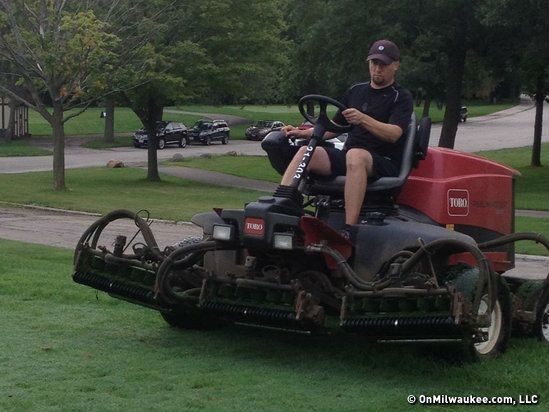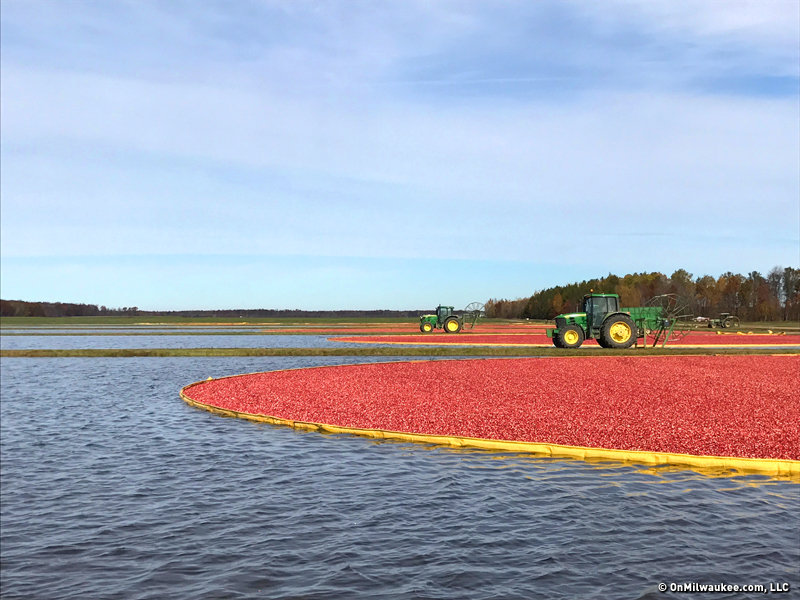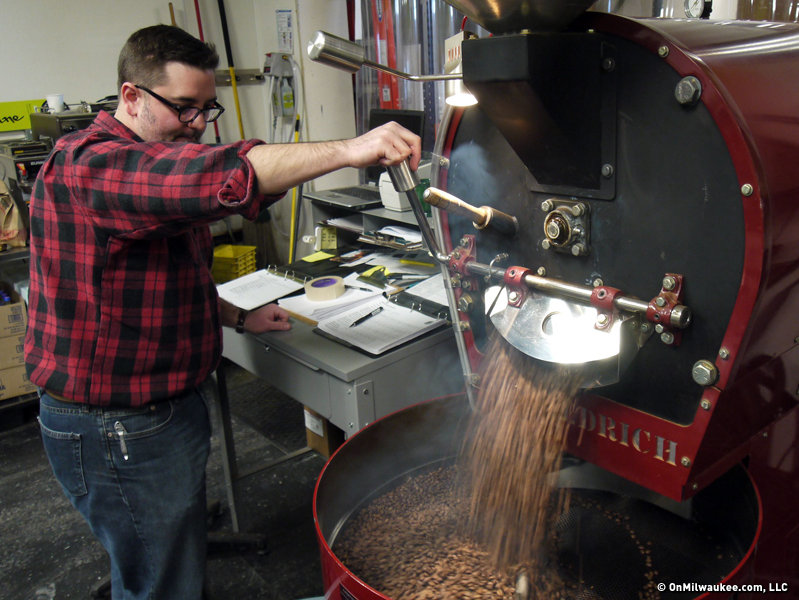Recently, I spent the morning shadowing Chef Karen Bell at Bavette La Boucherie, a butcher shop / cafe at 330 E. Menomonee St. While doing so, I learned a little bit about the process of butchering meat.
Prior to my "shift," I envisioned myself in a blood-spattered apron, wielding a bone saw and wearing big plastic goggles flecked with hog fat. This was not the case. In fact, I was surprised – and a little disappointed – by the lack of blood, guts and gore.
"People often confuse butchering with slaughtering," says Bell. "The meat is already slaughtered when we get it and the blood has already been drained out."
Historically, there have not been a plethora of female butchers, but the occupation has become more popular for women in recent years. Even if just for a couple of hours, I was proud to carve into a gender stereotype.
"It's not for everyone, but I find it very soothing and meditative," says Bell. "I think it’s pretty cool to start with a large animal and break it down."
Before we started, I admitted to Bell that even though I had been on a meat bender for a while, I spent more than a decade as a vegetarian and a few more years as a pescatarian – basically a vegetarian who eats fish. Bell told me she was a vegetarian in high school and doesn't consume as much meat as people might think.
After our brief meat-related confessional, Bell told me that every butcher eventually develops their own style and that it's much like any other art form.
"There’s no ‘right way’ to butcher meat. Everyone has their own way depending on what they want the final outcome to be," she says.
After I scrubbed my hands, Bell showed me how to hold the knife properly and told me to make quick, shallow cuts into the hog shoulder repeatedly rather than trying to make one or two deep slices.
The thought of performing surgery on a human grosses me out, and yet, I found butchery fascinating. I was oddly satisfied when cutting the muscle away from the bones, mostly because the knives – unlike mine at home – were sharp as fangs.
Bell says she sharpens her knives every day but she really doesn’t have a favorite type of butchering knife.
"I like the cheap ones," she says. "They are constantly going against the bone and grinding and so it doesn't make sense to use a really nice knife for butchering. Cooking is different."
Bell has offered in-house butchery instruction to the public and plans to resume classes again in 2015.
"Seeing the process gives people a new perspective on their food," says Bell. "And it really helps anyone who likes to cook meat dishes."
Bavette is one of the only shops in the state of Wisconsin practicing whole animal butchering, which means receiving all of the animal – usually in large pieces – as opposed to getting it in smaller cuts.
Whole-animal butchering can be physically challenging because even when the animals are split in half or into quarters the meat slabs still weigh around 100 pounds. But it ensures Bell that she's not wasting any of the animal – something that’s very important to her. Even the fat is used for sausage or lard and the bones for stock.
"We don't throw anything away except maybe some bland sinewy parts," says Bell.
Bell – along with full-time butcher, Bill Kreitmeir – cuts the meat out in the open and in view of customers and diners who choose to sit at the bar. There is also seating away from the carving table.
Before Bell committed to her current building she considered a smaller space which would have accommodated bar-only seating, meaning all of the diners would have been exposed to the butchering process.
"My family insisted that not everyone wants to see (butchering), but I was like, ‘why?’" says Bell.
Bell strongly believes that people who eat meat should know where their meat comes from and be aware of what happens between the pasture and the plate.
"People don’t have a problem seeing a raw steak, but when it’s a larger piece they sometimes feel weird about it," she says. "There’s often a disconnect between people and their food. So much of it comes in a neat, vacuum-packed square."
Bell gets most of her meat from Wisconsin farms and because it’s always fresh, some types of meat are only available at certain times of the year. Beef and pork are always available and she receives lamb about every other week.
Fresh chicken, however, has a short season and is only available from May to October. She is currently taking orders for fresh turkeys.
Bell received her culinary degree from Milwaukee Area Technical College (MATC) and studied at Le Cordon Bleu in Paris. She worked as a head line cook at Vong Restaurant, pastry cook at Charlie Trotter’s and at San Francisco's Farallon. She later opened her own restaurant, Memento, in Madrid, Spain and later returned to Milwaukee to revamp the menu at Cafe at the Plaza to include more local, seasonal dishes.
Kreitmeir – who learned to butcher in Germany at the age of 14 and spent 35 years at Grasch’s before coming to Bavette last May – gave me a few rules of thumb. (In order to keep all of my thumbs, perhaps?)
"You have to know how to hold a knife," he says. "You have to be very careful, so you don’t cut yourself. I stabbed myself in the stomach once."
He also said having a vast knowledge of all animals is important and recommends anyone interested in becoming a butcher should undergo a good apprenticeship.
These days, Kreitmeir says he prefers carving lamb and pork.
"I used to really like beef, but I’m getting older and I don’t have as much strength to throw it around like I used to," he says.
Personally, I walked away from my butchery stint with a newfound respect for the attractiveness of the meat I buy at the grocery store and also an understanding that although it's not as grisly as I'd imagined, butchery is not for the squeamish. After all, there is a fair share of clammy textures, rubbery red parts and shiny, exposed bones.
Bavette is open Monday and Tuesday from 10 a.m. to 5 p.m. and Wednesday-Saturday from 10 a.m. to 9 p.m. Fresh, raw meat to go is available along with ready-to-eat sandwiches, salads, snacks, spreads and more for dine-in or carry-out.
Molly Snyder started writing and publishing her work at the age 10, when her community newspaper printed her poem, "The Unicorn.” Since then, she's expanded beyond the subject of mythical creatures and written in many different mediums but, nearest and dearest to her heart, thousands of articles for OnMilwaukee.
Molly is a regular contributor to FOX6 News and numerous radio stations as well as the co-host of "Dandelions: A Podcast For Women.” She's received five Milwaukee Press Club Awards, served as the Pfister Narrator and is the Wisconsin State Fair’s Celebrity Cream Puff Eating Champion of 2019.







